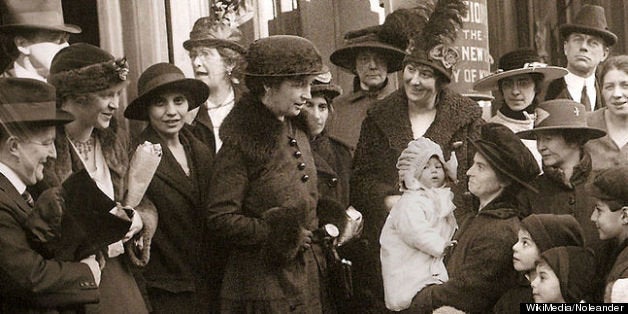
Several U.S. states are falling over themselves -- and in some cases failing -- to ban abortion, abortion clinics and access to the few clinics that remain. This is not a new phenomenon.
My grandmother, Margaret Sanger, began the birth control movement in the early 20th century. While early American law allowed for access to birth control and abortion, criminalization began in the 19th century. Then, the campaign to restrict reproductive freedom was primarily founded on the imperatives of organized medicine, the Protestant reaction to Irish Catholic immigration, and the drive for social "purity" in sexual matters.
During the 19th century, physicians began to unravel the mysteries of reproductive biology and fetal development. The ovum was discovered, as was the process of fertilization. The 19th century was also the time when university-trained physicians sought to control the practice of medicine.
Today, it is hard to imagine a time when there were few, if any, restrictions on who could practice medicine. In fact, until university-trained physicians appeared on the scene, midwives and other non-university trained doctors called "irregulars," as well as outright quacks, were the main practitioners. They not only diagnosed medical conditions, but also concocted and distributed all kinds of homemade drugs to their patients.
While official records are scarce, it seems that the first legislative restrictions on access to abortion were enacted as a result of efforts by "regular" physicians to protect the safety of women being treated by "irregulars" who earned a healthy part of their income by providing contraception, abortion and childbirth services. University-trained physicians also had an ulterior financial motive to put their competition -- irregulars, midwives and quacks -- out of business.
Physicians began to pressure legislatures to put the control of pregnancy prevention and termination in the hands of physicians only. The formation of the American Medical Association in 1841 by the physician-regulars accelerated the legislative process. They didn't bother to hide their financial motives. In "Abortion in America," James C. Mohr relates that the Southern Michigan Medical Society in 1875 was reminded by one of its members: "Regular physicians are still losing patients, even long time patients, to competitors willing 'to prevent an increase in their (patient's) families' by performing abortions."
Physicians alone were not able to bring about the criminalization of abortion. At the beginning of their campaign in the 1840s and 1850s, they aligned themselves with the Know-Nothings, a fledging political party of nativists opposed the tide of Irish-Catholic immigration into America, which had begun to increase exponentially with the potato famine. The Know-Nothings wanted to preserve control over the then-mostly Anglo-Saxon, Protestant society. Their platform was a mixture of nativism, temperance and religious bigotry that sought to restrict the voting and political representation rights of immigrants. The Know-Nothings feared that they, the native-born Protestants, would soon be outnumbered and outvoted by the new Catholic immigrants.
It did not escape Protestant notice that immigrant Catholic women had large numbers of children, while native Protestant women were having fewer. Since few new birth control methods had been introduced at this time -- although there were the beginnings of condom and diaphragm manufacturing -- the Know-Nothings suspected that Protestant women were using abortion as their method of birth control. Hence, the Know-Nothing men readily joined the AMA crusade to criminalize abortion. As contraceptive options increased in the course of the 19th century, those who favored the white Protestant hegemony also supported the criminalization of contraception. As one prominent physician said in 1874: "The annual destruction of fetuses has become so truly appalling among native American (Protestant) women that the Puritanic blood of '76 will be but sparingly represented in the approaching centenary."
Even though men took the lead in advancing the medical, political and racial arguments for the criminalization of birth control and abortion, some women were also in favor of this legislation. These women favored other "social purity" campaigns after the Civil War that sought to restrict gambling, drinking, prostitution and other immoral pursuits, including any expression of human sexuality other than that occurring between married couples for purposes of reproduction. Some feminists believed that birth control and abortion did more than enable voluntary motherhood; they also enabled husbands to consort more freely with "other women." These feminists believed that their own voluntary motherhood could be achieved by periodic abstinence and self-control.
The stars were thus aligned for Anthony Comstock, a YMCA official who headed the New York Society for the Suppression of Vice, to persuade Congress to enact his eponymous laws that prevented the publication or mailing of materials "designed, adapted, or intended for preventing conception or producing abortion, or for any indecent or immoral purpose." Individual states followed suit, and by the last quarter of the 19th century, birth control and abortion had essentially been criminalized at both the state and federal levels.
The result was not that birth control and abortion were thereby eliminated from American society; instead they went underground. We can surmise that many women had access to these services because the birth rate continued its century-long decline even after both were criminalized.
One woman who did not was my grandmother's mother, who had 11 children and several more miscarriages. She died at 49. My grandmother never forgot her mother's tragic death. It took her a lifetime to overturn the Comstock Laws, the last one falling after the 1965 Supreme Court Griswold v. Connecticut ruling.
It is not just legal abortion and Roe v. Wade but legal birth control and Griswold that today's opponents of reproductive freedom are trying to overturn. The ghost of Anthony Comstock still stalks the land.